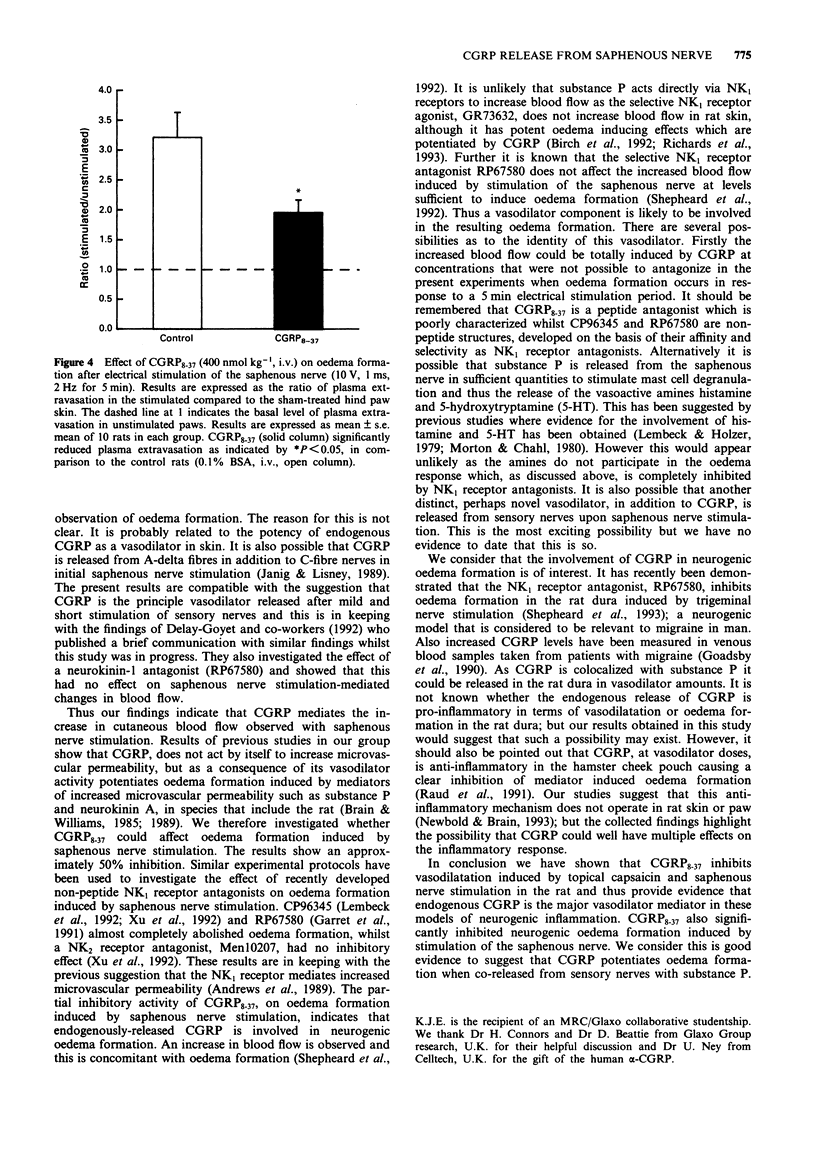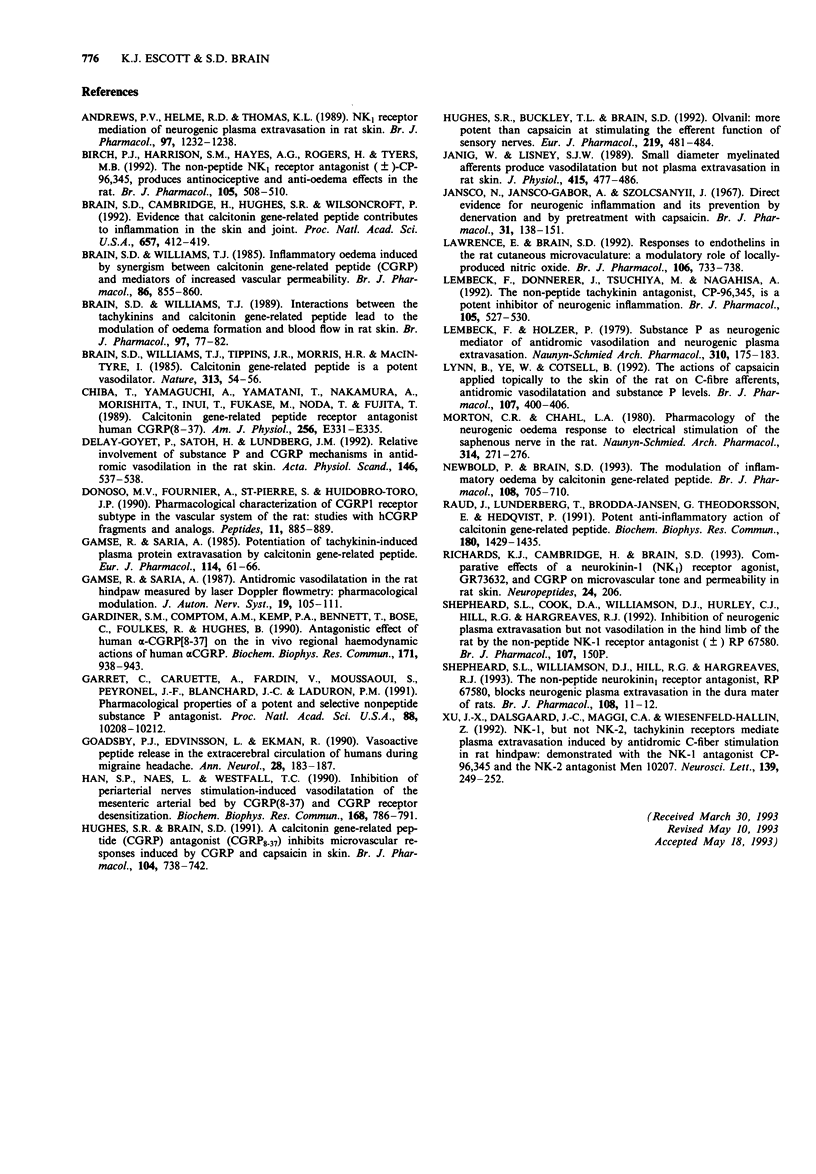Abstract
1. The effect of the calcitonin gene-related peptide antagonist (CGRP8-37, 400 nmol kg-1, i.v.) on the increased blood flow induced by calcitonin gene related peptide (CGRP), vasodilator prostaglandins, and topical capsaicin was measured with a laser Doppler blood flow meter in rat abdominal skin. 2. The saphenous nerve was electrically stimulated and the effect of CGRP8-37 (400 nmol kg-1, i.v.) on the increased blood flow (measured by laser Doppler flowmetry) and oedema formation (measured by the extravascular accumulation of [125I]-albumin) was investigated in the rat hind paw. 3. CGRP8-37 (400 nmol kg-1, i.v.) had no effect on basal cutaneous blood flow at uninjected sites and sites injected with Tyrode buffer, but acted selectively to inhibit the increased blood flow induced by intradermal CGRP (10 pmol/site, P < 0.05), but not that induced by prostaglandin E2 (PGE2, 300 pmol/site) or carba-prostacyclin (cPGI2, 100 pmol/site). 4. Capsaicin (0.1-33 mM), applied topically, acted in a dose-related manner to increase blood flow. CGRP8-37 (400 nmol kg-1, i.v.) almost totally inhibited blood flow induced by capsaicin (10 mM; P < 0.05) but did not significantly inhibit blood flow induced by a higher dose of capsaicin (33 mM). 5. The increased blood flow induced by short stimulation of the saphenous nerve (10 V, 1 ms, 2 Hz for 30 s) was inhibited by 76%, 5 min after i.v. CGRP8-37 (400 nmol kg-1, i.v., P < 0.05). 6. A longer (5 min) electrical stimulation of the saphenous nerve caused oedema formation, in addition to increased blood flow.(ABSTRACT TRUNCATED AT 250 WORDS)
Full text
PDF




Selected References
These references are in PubMed. This may not be the complete list of references from this article.
- Andrews P. V., Helme R. D., Thomas K. L. NK-1 receptor mediation of neurogenic plasma extravasation in rat skin. Br J Pharmacol. 1989 Aug;97(4):1232–1238. doi: 10.1111/j.1476-5381.1989.tb12583.x. [DOI] [PMC free article] [PubMed] [Google Scholar]
- Birch P. J., Harrison S. M., Hayes A. G., Rogers H., Tyers M. B. The non-peptide NK1 receptor antagonist, (+/-)-CP-96,345, produces antinociceptive and anti-oedema effects in the rat. Br J Pharmacol. 1992 Mar;105(3):508–510. doi: 10.1111/j.1476-5381.1992.tb09008.x. [DOI] [PMC free article] [PubMed] [Google Scholar]
- Brain S. D., Cambridge H., Hughes S. R., Wilsoncroft P. Evidence that calcitonin gene-related peptide contributes to inflammation in the skin and joint. Ann N Y Acad Sci. 1992 Jun 30;657:412–419. doi: 10.1111/j.1749-6632.1992.tb22787.x. [DOI] [PubMed] [Google Scholar]
- Brain S. D., Williams T. J. Inflammatory oedema induced by synergism between calcitonin gene-related peptide (CGRP) and mediators of increased vascular permeability. Br J Pharmacol. 1985 Dec;86(4):855–860. doi: 10.1111/j.1476-5381.1985.tb11107.x. [DOI] [PMC free article] [PubMed] [Google Scholar]
- Brain S. D., Williams T. J. Interactions between the tachykinins and calcitonin gene-related peptide lead to the modulation of oedema formation and blood flow in rat skin. Br J Pharmacol. 1989 May;97(1):77–82. doi: 10.1111/j.1476-5381.1989.tb11926.x. [DOI] [PMC free article] [PubMed] [Google Scholar]
- Brain S. D., Williams T. J., Tippins J. R., Morris H. R., MacIntyre I. Calcitonin gene-related peptide is a potent vasodilator. Nature. 1985 Jan 3;313(5997):54–56. doi: 10.1038/313054a0. [DOI] [PubMed] [Google Scholar]
- Chiba T., Yamaguchi A., Yamatani T., Nakamura A., Morishita T., Inui T., Fukase M., Noda T., Fujita T. Calcitonin gene-related peptide receptor antagonist human CGRP-(8-37). Am J Physiol. 1989 Feb;256(2 Pt 1):E331–E335. doi: 10.1152/ajpendo.1989.256.2.E331. [DOI] [PubMed] [Google Scholar]
- Delay-Goyet P., Satoh H., Lundberg J. M. Relative involvement of substance P and CGRP mechanisms in antidromic vasodilation in the rat skin. Acta Physiol Scand. 1992 Dec;146(4):537–538. doi: 10.1111/j.1748-1716.1992.tb09460.x. [DOI] [PubMed] [Google Scholar]
- Donoso M. V., Fournier A., St-Pierre S., Huidobro-Toro J. P. Pharmacological characterization of CGRP1 receptor subtype in the vascular system of the rat: studies with hCGRP fragments and analogs. Peptides. 1990 Sep-Oct;11(5):885–889. doi: 10.1016/0196-9781(90)90003-n. [DOI] [PubMed] [Google Scholar]
- Gamse R., Saria A. Antidromic vasodilatation in the rat hindpaw measured by laser Doppler flowmetry: pharmacological modulation. J Auton Nerv Syst. 1987 May;19(2):105–111. doi: 10.1016/0165-1838(87)90003-8. [DOI] [PubMed] [Google Scholar]
- Gamse R., Saria A. Potentiation of tachykinin-induced plasma protein extravasation by calcitonin gene-related peptide. Eur J Pharmacol. 1985 Aug 7;114(1):61–66. doi: 10.1016/0014-2999(85)90520-5. [DOI] [PubMed] [Google Scholar]
- Gardiner S. M., Compton A. M., Kemp P. A., Bennett T., Bose C., Foulkes R., Hughes B. Antagonistic effect of human alpha-CGRP [8-37] on the in vivo regional haemodynamic actions of human alpha-CGRP. Biochem Biophys Res Commun. 1990 Sep 28;171(3):938–943. doi: 10.1016/0006-291x(90)90774-h. [DOI] [PubMed] [Google Scholar]
- Garret C., Carruette A., Fardin V., Moussaoui S., Peyronel J. F., Blanchard J. C., Laduron P. M. Pharmacological properties of a potent and selective nonpeptide substance P antagonist. Proc Natl Acad Sci U S A. 1991 Nov 15;88(22):10208–10212. doi: 10.1073/pnas.88.22.10208. [DOI] [PMC free article] [PubMed] [Google Scholar]
- Goadsby P. J., Edvinsson L., Ekman R. Vasoactive peptide release in the extracerebral circulation of humans during migraine headache. Ann Neurol. 1990 Aug;28(2):183–187. doi: 10.1002/ana.410280213. [DOI] [PubMed] [Google Scholar]
- Han S. P., Naes L., Westfall T. C. Inhibition of periarterial nerve stimulation-induced vasodilation of the mesenteric arterial bed by CGRP (8-37) and CGRP receptor desensitization. Biochem Biophys Res Commun. 1990 Apr 30;168(2):786–791. doi: 10.1016/0006-291x(90)92390-l. [DOI] [PubMed] [Google Scholar]
- Hughes S. R., Brain S. D. A calcitonin gene-related peptide (CGRP) antagonist (CGRP8-37) inhibits microvascular responses induced by CGRP and capsaicin in skin. Br J Pharmacol. 1991 Nov;104(3):738–742. doi: 10.1111/j.1476-5381.1991.tb12497.x. [DOI] [PMC free article] [PubMed] [Google Scholar]
- Hughes S. R., Buckley T. L., Brain S. D. Olvanil: more potent than capsaicin at stimulating the efferent function of sensory nerves. Eur J Pharmacol. 1992 Sep 4;219(3):481–484. doi: 10.1016/0014-2999(92)90494-o. [DOI] [PubMed] [Google Scholar]
- Jancsó N., Jancsó-Gábor A., Szolcsányi J. Direct evidence for neurogenic inflammation and its prevention by denervation and by pretreatment with capsaicin. Br J Pharmacol Chemother. 1967 Sep;31(1):138–151. doi: 10.1111/j.1476-5381.1967.tb01984.x. [DOI] [PMC free article] [PubMed] [Google Scholar]
- Jänig W., Lisney S. J. Small diameter myelinated afferents produce vasodilatation but not plasma extravasation in rat skin. J Physiol. 1989 Aug;415:477–486. doi: 10.1113/jphysiol.1989.sp017732. [DOI] [PMC free article] [PubMed] [Google Scholar]
- Lawrence E., Brain S. D. Responses to endothelins in the rat cutaneous microvasculature: a modulatory role of locally-produced nitric oxide. Br J Pharmacol. 1992 Jul;106(3):733–738. doi: 10.1111/j.1476-5381.1992.tb14402.x. [DOI] [PMC free article] [PubMed] [Google Scholar]
- Lembeck F., Donnerer J., Tsuchiya M., Nagahisa A. The non-peptide tachykinin antagonist, CP-96,345, is a potent inhibitor of neurogenic inflammation. Br J Pharmacol. 1992 Mar;105(3):527–530. doi: 10.1111/j.1476-5381.1992.tb09013.x. [DOI] [PMC free article] [PubMed] [Google Scholar]
- Lembeck F., Holzer P. Substance P as neurogenic mediator of antidromic vasodilation and neurogenic plasma extravasation. Naunyn Schmiedebergs Arch Pharmacol. 1979 Dec;310(2):175–183. doi: 10.1007/BF00500282. [DOI] [PubMed] [Google Scholar]
- Lynn B., Ye W., Cotsell B. The actions of capsaicin applied topically to the skin of the rat on C-fibre afferents, antidromic vasodilatation and substance P levels. Br J Pharmacol. 1992 Oct;107(2):400–406. doi: 10.1111/j.1476-5381.1992.tb12758.x. [DOI] [PMC free article] [PubMed] [Google Scholar]
- Morton C. R., Chahl L. A. Pharmacology of the neurogenic oedema response to electrical stimulation of the saphenous nerve in the rat. Naunyn Schmiedebergs Arch Pharmacol. 1980 Nov;314(3):271–276. doi: 10.1007/BF00498549. [DOI] [PubMed] [Google Scholar]
- Newbold P., Brain S. D. The modulation of inflammatory oedema by calcitonin gene-related peptide. Br J Pharmacol. 1993 Mar;108(3):705–710. doi: 10.1111/j.1476-5381.1993.tb12865.x. [DOI] [PMC free article] [PubMed] [Google Scholar]
- Raud J., Lundeberg T., Brodda-Jansen G., Theodorsson E., Hedqvist P. Potent anti-inflammatory action of calcitonin gene-related peptide. Biochem Biophys Res Commun. 1991 Nov 14;180(3):1429–1435. doi: 10.1016/s0006-291x(05)81356-7. [DOI] [PubMed] [Google Scholar]
- Shepheard S. L., Williamson D. J., Hill R. G., Hargreaves R. J. The non-peptide neurokinin1 receptor antagonist, RP 67580, blocks neurogenic plasma extravasation in the dura mater of rats. Br J Pharmacol. 1993 Jan;108(1):11–12. doi: 10.1111/j.1476-5381.1993.tb13432.x. [DOI] [PMC free article] [PubMed] [Google Scholar]
- Xu X. J., Dalsgaard C. J., Maggi C. A., Wiesenfeld-Hallin Z. NK-1, but not NK-2, tachykinin receptors mediate plasma extravasation induced by antidromic C-fiber stimulation in rat hindpaw: demonstrated with the NK-1 antagonist CP-96,345 and the NK-2 antagonist Men 10207. Neurosci Lett. 1992 May 25;139(2):249–252. doi: 10.1016/0304-3940(92)90564-n. [DOI] [PubMed] [Google Scholar]


